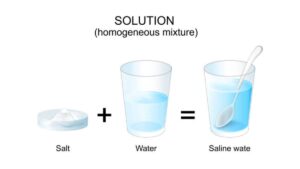The National Eligibility cum Entrance Test (NEET) is one of the most competitive exams in India for students aspiring to pursue a career in medicine. The Physics section of the NEET exam encompasses various fundamental topics that test a student’s understanding of core concepts. One such critical chapter is Properties of Solids and Liquids, which carries a significant weightage in the exam.
In this blog, we’ve shared MCQs (Multiple Choice Questions) related to the Properties of Solids and Liquids chapter, providing both detailed explanations and essential tips for NEET aspirants to improve their preparation.
NEET Physics MCQs for Properties of Solids and Liquids Chapter
The Properties of Solids and Liquids is an important chapter of the NEET Physics Syllabus 2026, which deals with the study related to Properties of Solids, Properties of Liquids, Streamline & Turbulent Flow, Reynolds Number, Bernoulli’s Principle, Moduli of Elasticity, Hooke’s Law, etc.
All the students of class 12th who are preparing for the NEET 2026 exam must start by studying all the important topics mentioned in the NEET Syllabus 2026 for Physics subject. Solving more and more NEET Physics MCQs for Properties of Solids and Liquids Chapter is beneficial for the students as it enhances student’s chances and preparations for the NEET Exam 2026.
Understanding the Properties of Solids and Liquids
Before diving into the MCQs, it is crucial to understand the basic concepts of solids and liquids, which form the foundation for this chapter. The Properties of Solids and Liquids chapter involves studying the physical properties that distinguish solids and liquids from one another. Some of the key topics include:
- Elasticity in solids
- Surface tension in liquids
- Viscosity in fluids
- Young’s Modulus
- Fluid statics and dynamics
- Bernoulli’s Principle
- Capillary rise
Grasping these concepts is essential, as the NEET exam often includes questions that require a deep understanding of both theoretical and practical applications.
Key Topics for NEET Physics MCQs for Properties of Solids and Liquids Chapter
Let’s break down some key areas within the Properties of Solids and Liquids chapter, and then we will explore some sample MCQs to help you prepare effectively for the exam.
1. Elasticity and Stress-Strain Relationship
Elasticity is the property of a material to return to its original shape after the deforming force is removed. The stress-strain curve and concepts like Young’s Modulus, Bulk Modulus, and Shear Modulus are fundamental for understanding how solids deform under stress.
Key Formulae:
- Stress = Force / Area
- Strain = Change in Length / Original Length
- Young’s Modulus = Stress / Strain
2. Surface Tension and Surface Energy
Surface tension is the force acting on the surface of a liquid that minimizes its surface area. This concept is essential for understanding phenomena like capillary action, wetting, and droplets.
Key Formulae:
- Surface Tension (T) = Force / Length
- Height of capillary rise (h) = 2Tcos(θ) / (ρgR)
3. Viscosity of Fluids
Viscosity refers to the resistance of a fluid to flow. It is an important property for understanding the movement of fluids in pipes and blood flow in capillaries.
Key Formulae:
-
Viscosity (η) = Force × Distance / (Velocity × Area)
4. Fluids in Motion: Bernoulli’s Principle and Continuity Equation
In this section, you will learn how to apply Bernoulli’s equation to explain the behavior of moving fluids. The Continuity Equation and Bernoulli’s Theorem are crucial to understanding fluid dynamics.
Key Formulae:
- Continuity Equation: A₁v₁ = A₂v₂
- Bernoulli’s Equation: P + ½ρv² + ρgh = constant
5. Fluid Statics: Pressure in Fluids
Understanding the pressure exerted by fluids and the effect of gravity is vital. Hydrostatic Pressure, Archimedes’ Principle, and Buoyancy play key roles in determining the behavior of objects submerged in fluids.
Key Formulae:
- Pressure (P) = ρgh
- Buoyant Force (F) = ρVg
NEET Physics MCQs on Properties of Solids and Liquids Chapter
Ahead, we have added some of the NEET Physics MCQs for Properties of Solids and Liquids Chapter so that all the students appearing for the exam can check and complete their preparations for the same using them. Scroll down in the article below to check the NEET Physics MCQs on Properties of Solids and Liquids Chapter:
MCQ 1: What is the unit of Young’s Modulus?
A) N/m²
B) N
C) m²
D) N·m
Answer: A) N/m²
Explanation: The unit of Young’s Modulus is N/m² (Newton per square meter), which is the same as pressure.
Question 2: Which of the following is true about surface tension?
A) It always acts perpendicular to the surface.
B) It always acts parallel to the surface.
C) It decreases with an increase in temperature.
D) It has no effect on the shape of the liquid.
Answer: A) It always acts perpendicular to the surface.
Explanation: Surface tension acts tangentially at the surface of the liquid and tends to minimize the surface area.
Question 3: A fluid flows through a pipe, and its viscosity is measured. Which of the following factors affects the viscosity of the fluid?
A) Pressure
B) Temperature
C) Velocity
D) All of the above
Answer: B) Temperature
Explanation: The viscosity of a fluid decreases with an increase in temperature. Pressure and velocity have less direct effects.
Question 4: What causes the rise of liquid in a capillary tube?
A) Surface tension
B) Viscosity
C) Gravitational force
D) Temperature
Answer: A) Surface tension
Explanation: Capillary action is caused by surface tension, which pulls the liquid upwards through the narrow tube against the force of gravity.
Question 5: According to Bernoulli’s principle, which of the following is true for an incompressible, steady flow of a fluid?
A) The total pressure is constant.
B) The velocity is constant.
C) The velocity increases with an increase in pressure.
D) The total energy is constant.
Answer: D) The total energy is constant.
Explanation: Bernoulli’s principle states that for an incompressible, steady flow of a fluid, the total energy (pressure energy, kinetic energy, and potential energy) remains constant.
Question 6: A column of mercury of height 100 cm is placed vertically. The pressure at the bottom of the column is:
A) 100 Pa
B) 1000 Pa
C) 1 kPa
D) 10 kPa
Answer: C) 1 kPa
Explanation: The pressure at the bottom of the column is given by the formula
. For mercury, the density is
, and using the height of 1 meter, the pressure is approximately 1 kPa.
Year-Wise NEET Physics MCQs for Properties of Solids and Liquids Chapter
In the table listed below, we have added the year-wise NEET Physics MCQs for the Properties of Solids and Liquids Chapter so that all the students can start preparing accordingly. Click on the links below:
| Year-Wise NEET Physics MCQs for Properties of Solids and Liquids Chapter | |
| Year | Links |
| 2014 | Click Here |
| 2015 | Click Here |
| 2016 | Click Here |
| 2017 | Click Here |
| 2018 | Click Here |
| NEET Physics Chapters | MCQ Link |
|---|---|
| Physics and Measurement | Click Here |
| Kinematics | Click Here |
| Laws of Motion | Click Here |
| Work, Energy, and Power | Click Here |
| Rotational Motion | Click Here |
| Gravitation | Click Here |
| Properties of Solids and Liquids | Click Here |
| Thermodynamics | Click Here |
| Kinetic Theory of Gases | Click Here |
| Oscillation and Waves | Click Here |
| Electrostatics | Click Here |
| Current Electricity | Click Here |
| Magnetic Effects of Current and Magnetism | Click Here |
| Electromagnetic Induction and Alternating Currents | Click Here |










 NEET Preparation Strategy 2026: Detailed...
NEET Preparation Strategy 2026: Detailed...
 Free NEET Sample Papers 2026 PDF | Downl...
Free NEET Sample Papers 2026 PDF | Downl...
 Salt Analysis NEET Notes, Check Importan...
Salt Analysis NEET Notes, Check Importan...








